For centuries, Britain's main enemy was France. As a result, the start of the 20th century found the south and southeast coasts dotted with naval bases, bases protected by fortifications. But the threat was changing from France to Germany, and new bases would be needed to cover the North Sea. The Grand Fleet would have to be based somewhere in Scotland, putting it in position to bottle up the German fleet. Several locations were considered, most notably Cromarty Firth and the Firth of Forth, both on the eastern coast of the Scottish mainland. But both of these had only a single entrance, raising the possibility of mines trapping the fleet in harbor. This tipped the balance in favor of the third option, the Orkney harbor of Scapa Flow, off the northeastern tip of Scotland.
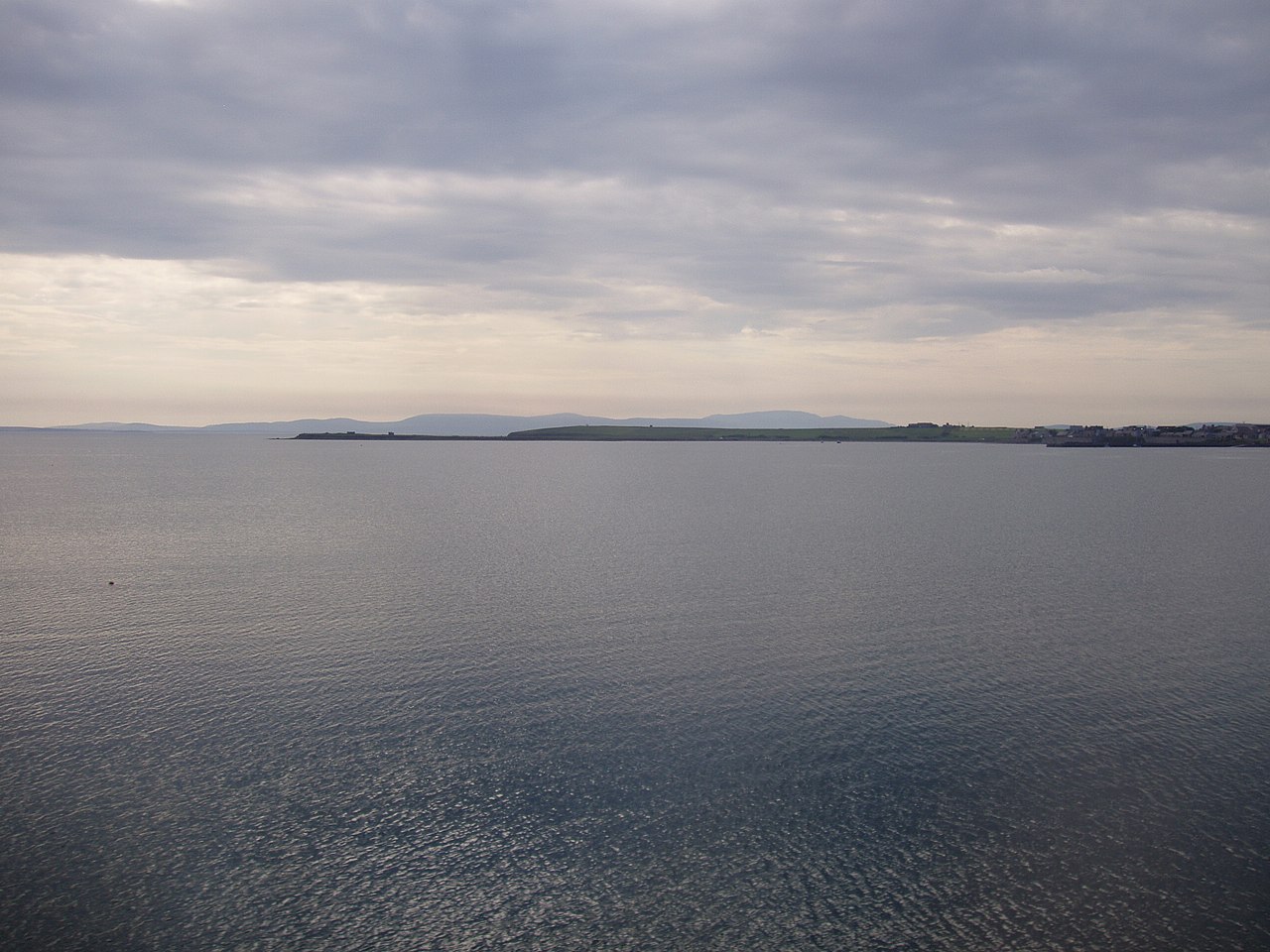
Scapa Flow today
But while work had been undertaken to defend the Firth of Forth as early as the 1870s, the outbreak of war found the defenses of Scapa still no more than paper and a local unit recruited to man them when they were finally built. Jellicoe quickly ordered some of his ships to send a few of their smaller guns, 3" or less, ashore to cover the entrances to the Flow against a potential attack, and had fishing nets strung to hopefully indicate if a submarine attempted to penetrate. But nobody had much confidence in these measures, and after a submarine scare in September resulted in wild firing by nervous gunners, the Grand Fleet withdrew to the waters around western Scotland and Ireland, although even this wasn't enough to avoid loss to German mines.
The first task in protecting Scapa was to reduce the number of possible entrances to the Flow, which is surrounded by a number of islands. Of the eight natural passages in and out, the five smallest were closed by the simple expedient of sinking blockships, obsolete merchant ships, in the channels and backing them up with anti-submarine obstacles. The other three, Hoxa Sound and Switha Sound in the south and Hoy Sound in the west, received the most attention. To counter the threat of destroyer attack, a heavy wooden boom was laid across each in the hopes of stopping or at least slowing them, and allowing the coastal batteries to finish them off. Anti-submarine nets were hung below the booms, and converted drifters were used to open and close the gates that allowed ships to pass in and out. Further protection against submarines came from the use of induction loops, long metal cables laid on the seabed. A submarine passing over would produce a current, which could be picked up by the monitoring station ashore. They would alert the gunners, searchlight operators, hydrophone posts and mine operators, who would wait for the right moment, then set off their lethal charges.
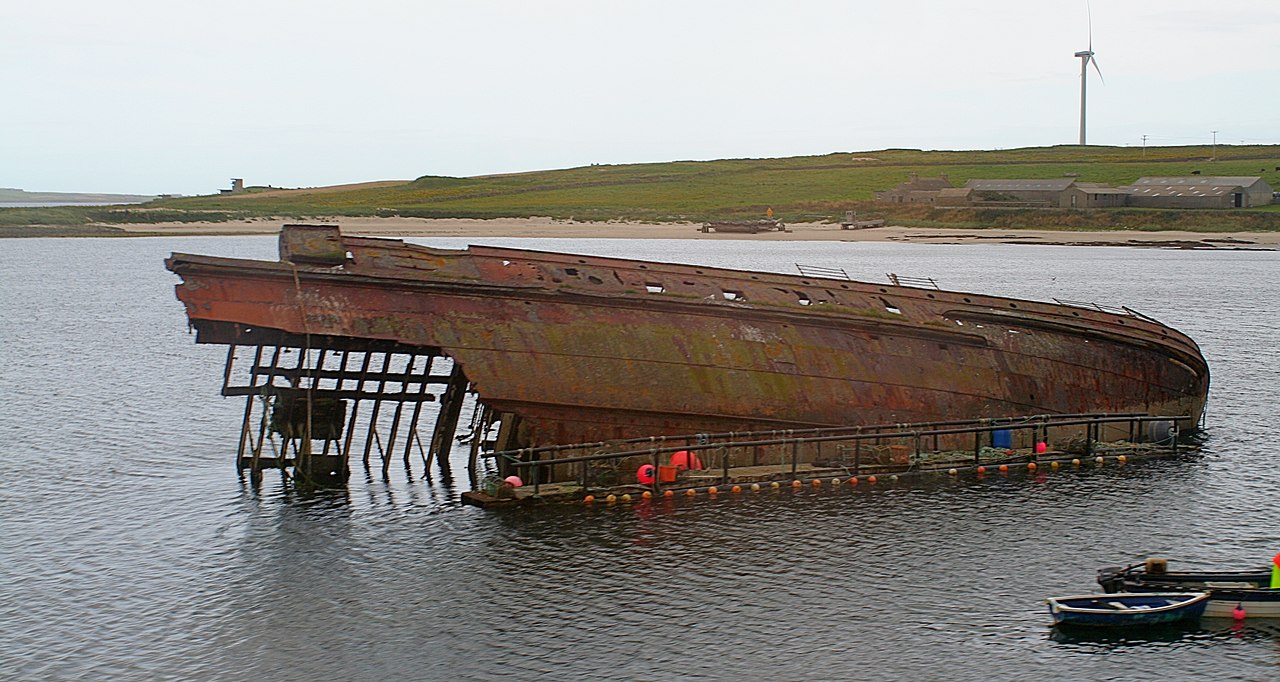
A blockship in the Orkneys
The coastal batteries were also optimized for the destroyer threat, presumably because Scapa wasn't much of a target when the Grand Fleet was absent, and the Grand Fleet was capable of dealing with an attack if it was present. Hoy Sound was covered by two batteries with two 6" guns each and a battery of three 5.5" guns bought from Bethlehem Steel in the US due to a lack of suitable British guns, backed up further down by a number of 12 pdr guns. Hoxa Sound, the main entrance, was covered by 2 6" and 4 4" batteries, each with two guns, and backed up by more 12 pdrs further in. Switha Sound, narrow and too shallow for the big ships but useful for access by lighter vessels to the naval HQ in the Orkneys, was guarded by 2 4.7" weapons, while Kirk Sound remained accessible to small craft willing to weave their way around the blockships, and thus required 3 4" guns of its own. Permanent installations of these batteries began in the spring of 1915, with work continuing through mid-1916. Each of the guns was mounted in an open emplacement of concrete and earth, with a small local magazine and a larger underground magazine supplying the entire battery. Each required a number of supporting structures, including observation posts, searchlights, barracks and offices.
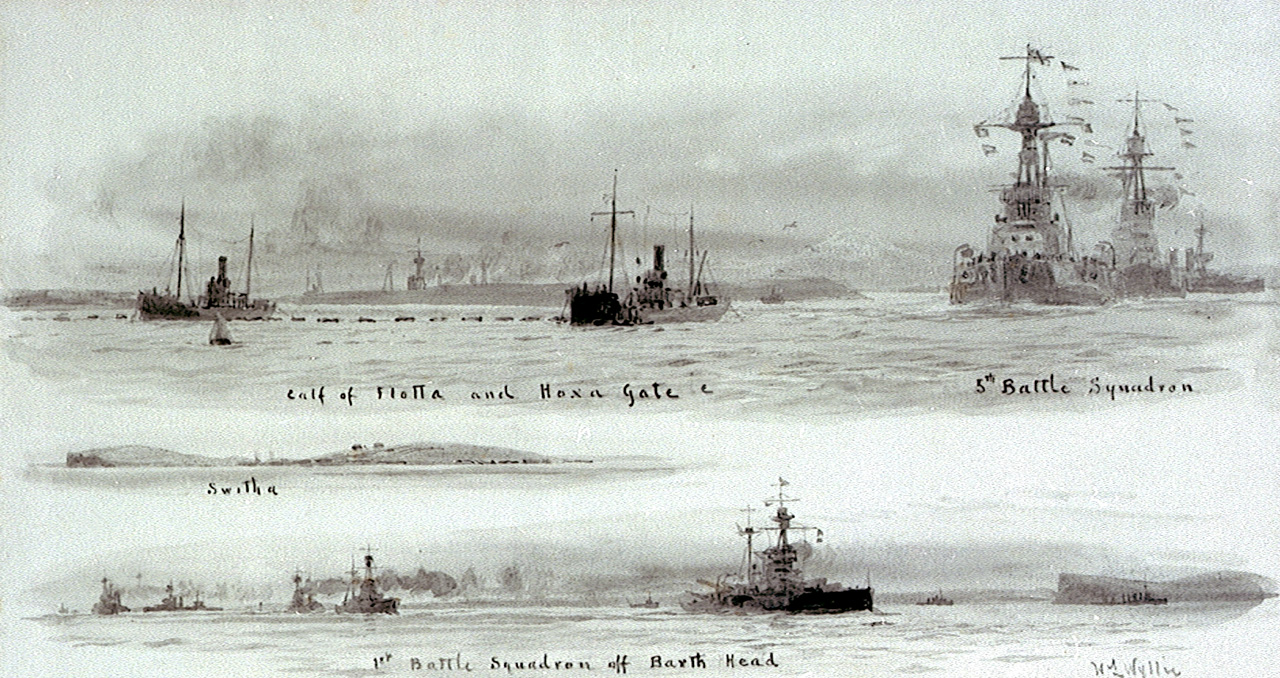
Air power was beginning to play a role in coastal defense, and Scapa was a beneficiary, with the Royal Naval Air Service (RNAS) stationing seaplanes in the Orkneys as early as September 1914, soon backed up by landplanes, blimps and kite balloons. The defenses worked quite effectively, with the only submarine to penetrate Scapa, U-18, doing so in November 1914, before most were in place, and she was rammed and sunk by the British. At the very end of the war, UB-116 made another attempt on Scapa in support of the German plan for a cataclysmic fleet action, but she was detected and destroyed by the controlled minefield.
With the end of the war, the defenses were largely dismantled, with the guns placed in storage and the booms removed. The Admiralty did prove reluctant to remove the blockships, and many were still in place in 1939, when Scapa was called to duty again. But the other defenses had withered, and all that protected the base was 4 6" guns, left over from WWI, and a battery of 8 3.7" AA guns stationed around the new oil tanks at Lyness. But booms were in place across the main entrances, the Fleet Air Arm was setting up a base for fighters, and more guns were on the way.
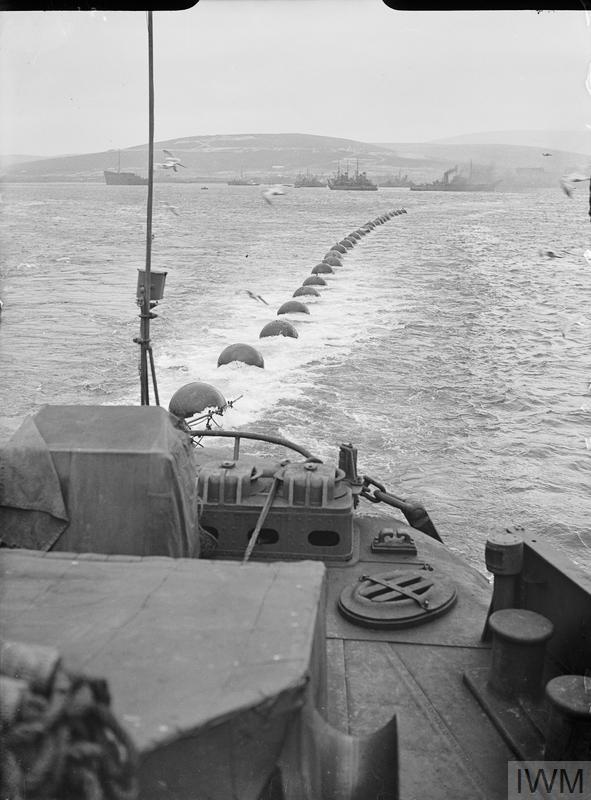
A boom is towed into position
There was only one major chink in the defenses: Kirk Sound, on the east side of Scapa. It was one of the entrances that had received blockships in WWI, but a small channel had been left open to allow local fishing boats in and out, and by mid-1939, inspections revealed that it was probably navigable even for a submarine. Another old ship, Lake Neuchatel, was purchased to block the channel, and on the night of October 14th, she was in the Flow, waiting to be towed into position.
Tragically, the British acted slightly too late. That night, U-47, under the command of Gunther Prien, penetrated through Kirk Sound and pumped three torpedoes into the anchored battleship Royal Oak, sending her to the bottom along with 833 of her crew before slipping back out, again through Kirk Sound. This attack, followed three days later by the first German air attack on Scapa, sent shockwaves through the British military, and forced Home Fleet, successor to the Grand Fleet, to disperse from Scapa to other anchorages, weakening its ability to deal with the Germans if they came out. A crash program to build up the defenses in the Orkneys was launched, with troops arriving to protect against invasion, heavy and light AA guns, new coastal batteries and better ASW defenses.
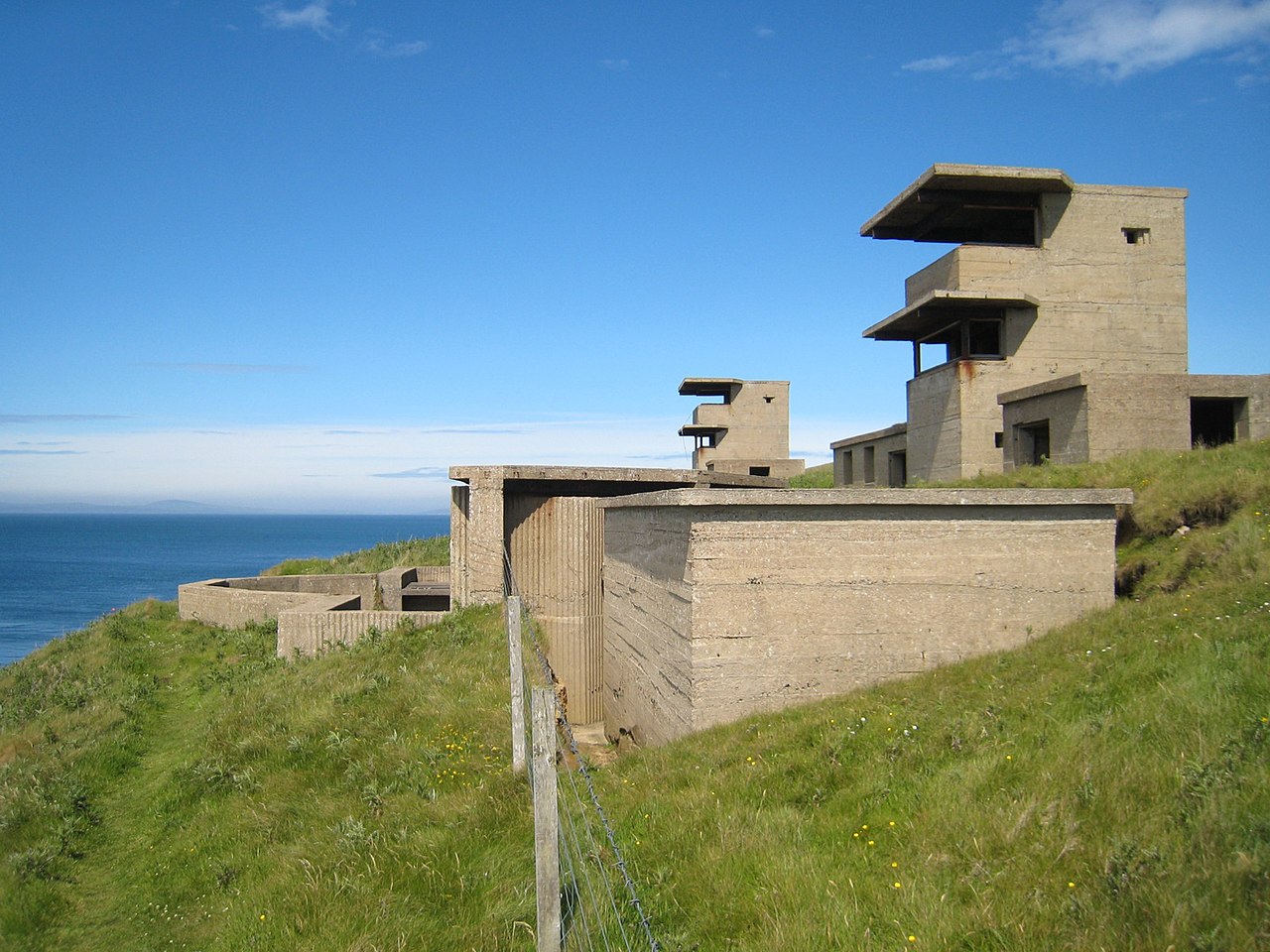
The remains of a gun battery at Hoxa Head
Churchill, then at the Admiralty, setting a target of March 1st for Home Fleet's return. This was extended a week, but on March 8th, Churchill himself led the way into the harbor. The return was just in time, placing Home Fleet in position to intervene in the German attack on Norway a month later. Unfortunately, this wasn't enough to save that country, which brought German bombers within easy range of Scapa. This threat was countered by extensive AA arrangements, including radar stations for both air and surface search, at least 88 heavy AA guns and 100 searchlights, along with extensive light AA batteries ranging from Bren Guns to Bofors. 80 barrage balloons made extremely low-level attacks hazardous, while several novel systems, including a large rocket battery and smoke screens, were tried and found wanting. As an outer line of defense, fighters were stationed at a number of airfields around the Orkneys.
Eventually, a total of 19 batteries were installed to protect the Orkneys against surface attack. A few had 6" and 4.7" guns for use against destroyers, but the majority were equipped with 12 pdr or 6 pdr QF guns to guard against a new threat, the motor torpedo boat. Pillboxes and barbed wire were used to guard these batteries against the possibility of commando raids or even a full-scale amphibious invasion, which couldn't be ruled out in the aftermath of German successes in Norway.
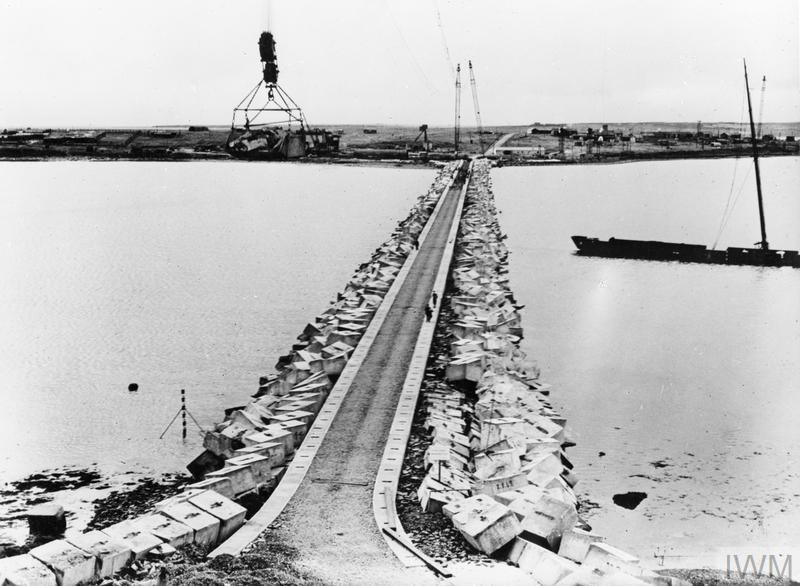
A Churchill Barrier under construction
Underwater defenses initially mirrored WWI experience, with indicator loops, minefields, booms and anti-submarine nets. Maintaining all of this took constant work, with the minefields in particular having to be detonated and re-sown frequently for safety reasons, a procedure which was strangely popular with the men stationed at Scapa. More anti-submarine nets were placed within the Flow to prevent a repeat of U-47's raid, and they were supplemented from 1942 to 1944 by Landing Craft Tanks fitted with anti-torpedo baffles and placed around the larger ships. But Churchill wasn't satisfied with the security of the eastern channels, and ordered construction of causeways across four of them, producing the "Churchill Barriers" that remain in place today, providing a road connection between the islands. Work began in 1940, but they were not completed until 1944. By that point, the defenses were being drawn down, with the searchlights withdrawn, the heavy AA batteries moved to defend London from the V-1s and the troops cut back as the invasion of France approached. Postwar, it was clear that Scapa wouldn't be needed in the same way again, and the defenses were abandoned, with many of the structures littering the Orcadian landscape today.
Scapa is an interesting study in coastal defenses of the early 20th century. It was perhaps the most strategic port in the world during both World Wars, but it was also isolated and negelcted before each one. While most permanent bases were guarded by heavy guns and extensive prepared works, everything that protected Scapa was built in a hurry during or just before the war. But it was far from the only place that was fortified during the war, as we will see next time.

Comments
I love how Scapa was chosen for its multiple entrances, and then they have to put so much work into closing most of them down.
You left out the scuttling of the High Seas Fleet!
I drank a lot of beer with an Orkneys man in the 2000s and he stated that to this day you can go and climb into scuttled destroyers. I have no knowledge whether this is true or not.
You left out the scuttling of the High Seas Fleet!
I drank a lot of beer with an Orkneys man in the 2000s and he stated that to this day you can go and climb into scuttled destroyers. I have no knowledge whether this is true or not.
I didn't leave it out by accident. This was about the coastal defenses, not a history of Scapa in general, and that particular topic is one that very much doesn't fit into the coastal defenses rubric. Also, I've covered that before.
How wide and deep do channels need to be for battleships and destroyers? It's just that I found this bathymetric map on Scotland's website.
https://www.gov.scot/binaries/content/gallery/publications/report/2016/03/scottish-shelf-model-part-2-pentland-firth-orkney-waters-sub/00495684.jpg
You can see Scapa Flow in the upper right, to the West of the Churchill Barriers and North of Hoxa sound.
Double posting, Triple posting.
Should I try quadruple posting?
@Lambert
Figure 40' or so for battleships, which typically draw ~30' of water, and want some safety margin. Maybe 10-15' less for destroyers, although it's going to matter a lot which destroyers. Of course, Scapa is a home for oil tankers these days, so neither of those numbers should be a problem.
@Anonymous
That happens from time to time. I just had't gotten around to cleaning it up.